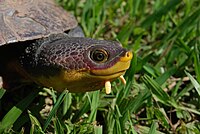
Photo from wikipedia
Ectoparasites such as hematophagous leeches and monogeneans are common in chelonians, occupying different parts of the body. Thus, the present study aimed to identify and describe the fauna of ectoparasites… Click to show full abstract
Ectoparasites such as hematophagous leeches and monogeneans are common in chelonians, occupying different parts of the body. Thus, the present study aimed to identify and describe the fauna of ectoparasites that infest Phrynops geoffroanus and Mesoclemmys tuberculata to evaluate the effect of host conditions and seasonality (dry and rainy season) on the abundance and composition of ectoparasites. We verified the presence of ectoparasites in 73.2% of the examined turtles, with four species of leeches belonging to Glossiphoniidae, Haementeria brasiliensis sensu Cordero, 1937, Helobdella cf. adiastola, Haementeria sp1., and Haementeria sp2., and one monogenean Polystomatidae, Polystomoides brasiliensis. For both chelonians, we observed a significant difference in the abundance of ectoparasites in relation to sex, biome, and season, which was unrelated to length and mass. Leeches were more frequent in the cavities of the hind limbs in P. geoffroanus, and the anterior limbs of M. tuberculata. The general spatial niche overlap of ectoparasites was high, except for that of the monogenean P. brasiliensis, which did not overlap with those of other leech species. The present study is the first report of the presence of H. brasiliensis and P. brasiliensis parasitizing M. tuberculata, and Helobdella cf. adiastola in a phoretic relationship with P. geoffroanus and M. tuberculata. Finally, the differences in infestation levels may reflect ecological factors, differences in behavioral patterns of the hosts, and different anthropic alterations suffered in the Caatinga and Atlantic Forest biomes.
Journal Title: Parasitology Research
Year Published: 2019
Link to full text (if available)
Share on Social Media: Sign Up to like & get
recommendations!